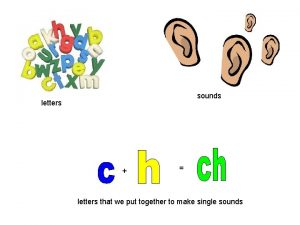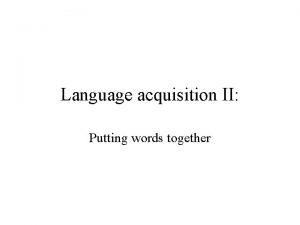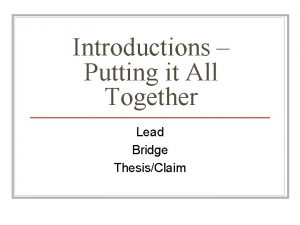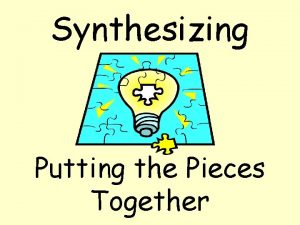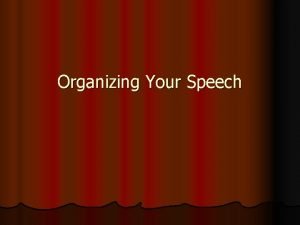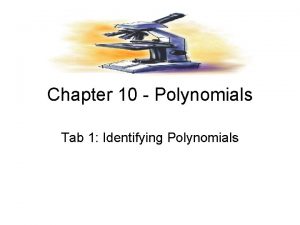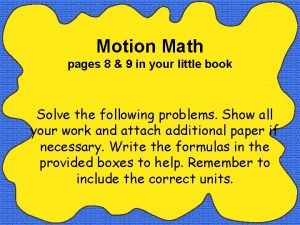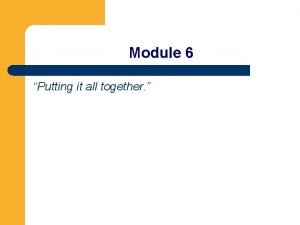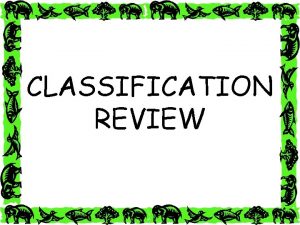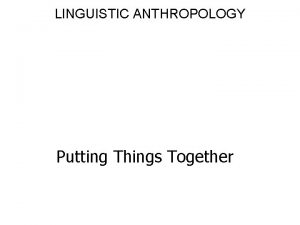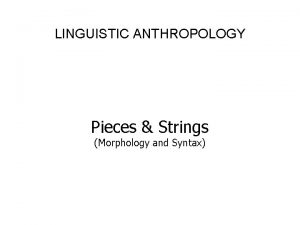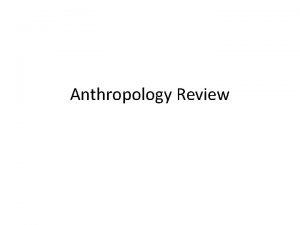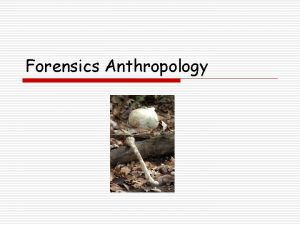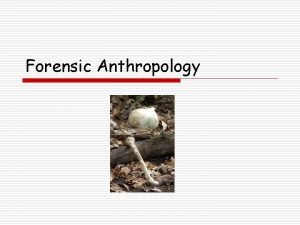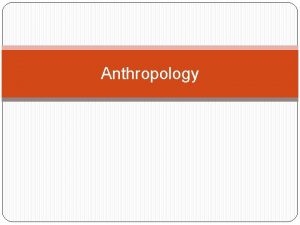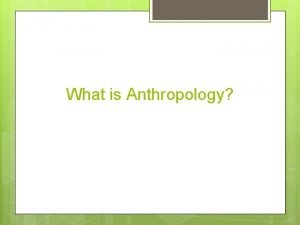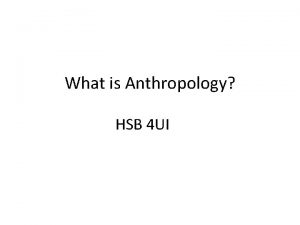Linguistic Anthropology Putting Things Together Overview From Morphology
















- Slides: 16

Linguistic Anthropology Putting Things Together

Overview • From Morphology • The analysis of words • and how they are structured • To Syntax • The analysis of phrases and sentences • and how they are structured

Morphology • Words vs. morphemes • Morphemes as smallest units of meaning in a language • respect+ful; dis+respect+ful • room+mate; stir+fry • fire+fight+er • Manhattan

Morphological Analysis • Describing morphemes… • Analyzing their arrangements…

Describing Morphemes: Bases • Form foundations of words • Establish basic meanings • English: fish; talk • Shinzwani: -lo- (fish); -lagu- (talk) • Czech: piv- (beer)

Kinds of Bases Roots STEMS (derived from roots) • Serve as underlying foundation • Can’t be broken down any further • English: fish • Shinzwani: -lo- (fish) • By means of affixes • English: fish+ing = fishing; talk+er = talker • Shinzwani: lo+a = -loa (fishing) • Can have additional affixes attached • English: talker+s = talkers • Shinzwani: ni+ku+loa = nikuloa (I am fishing).

Creating a Language: Bases Some of the base forms you may wish to create • 9 -12 things • visible body parts, movable items, parts of the room • 4 -6 actions • sit, stand, give, touch, open, close, lift, put down • 2 -6 persons • you, me, I, we, he/she/it, you/y’all, we two, we three • 6 -8 descriptors • size, color, number • 2 -5 indicators/places • the, a, this, that-overthere, in, at, on, under • Anything else of interest (consider your cultural focus) Remember to use only sounds in your charts.

Describing Morphemes: Affixes • Attach to bases • Add grammatical information • English: -er; -ing • = fisher, fishing, talker, talking • Shinzwani: hu- (to) ; niku- (I am) • = huloa (to fish), hulagua (to talk) • = nikuloa (I am fishing), nikulagua (I am talking) • Czech: -o; -a; -Ø • = pivo (beer), piva ((2, 3, 4) beers), piv ((5+) beers).

Kinds of Affixes • Prefixes • im+possible • un+likely • Suffixes • walk+ing • Infixes • fan+bloody+tastic • Circumfixes • m+loz+i (fisherman) • Reduplication • mpole+mpole (very slow) • Interweaving • k+i+t+aa+b (book) • Portmanteau • blog

What Affixes DO • Derivation • Changing one kind of word into another • verbs into nouns: read -- reader; -lo- -- mlozi • adjectives into verbs: modern -- modernize • Inflection • Showing relationships among words in a group • tenses: hunted -- hunting • comparisons: big -- bigger -- biggest • persons: I fish -- she fishes • number: cat -- cats; mpaha – zimpaha (cat/cats)

Creating a Language: Affixes • To go with your base forms, please create: • an affix to derive one kind of word from another • e. g. , things from actions, or actions from things • an affix to inflect one kind of word • For example: • • • gender: male, female, neuter. . . number: single, plural, dual, triple, inclusive, exclusive… shape: flat, thin, round, square, oblong, 3 -D, floppy. . . time: now, soon, never, always, yesterday, tomorrow… validity: witnessed, heard about, heard from reliable source… comparison: strong, stronger, strongest. . . • Remember to only use sounds in your charts!

Analyzing Arrangement: Free and Bound Morphemes • Free morphemes are like bases • Can stand alone • e. g. , words: speak; respect; Manhattan • Bound morphemes are like affixes • Must be attached to other morphemes • e. g. , affixes: -er; -ing; dis-; -ful • speak-er; speak-ing; dis-respect-ful • But note: roots can also be BOUND MORPHEMES • e. g. , Shinzwani -lo- ‘fish’, Czech piv- ‘beer’ • Hierarchy among affixes • English: derive first, then inflect… • help+er+s (not help+s+er)

Syntax • How words combine into phrases & sentences • Note fuzzy boundary between morphology and syntax • Shinzwani: ni+tso+hu+venza ‘I+will+you+like’ • All one word • English: I will like you • Four different words

Analyzing Syntax • Finding and testing substitution frames • Also called ‘slots and fillers’ • The cat in the hat • The cat in the basket • The cat in the tree • M+paha i+send+a mji+ni – the cat is going to town • M+wana a+send+a mji+ni – the child is going to town • Gari li+send+a mji+ni – the car is going to town • M+tu m+zuri m+moja u+le – that one good person • Ki+kapu ki+zuri ki+moja ki+le – that one good basket • Gari zuri moja li+le – that one good car

Labeling Substitution Frames • Let the language be your guide • Be prepared for different categories • Grammatical gender • Czech: masculine, feminine, neuter • Shinzwani: human, animal, body part, useful, abstract • Case • Czech: subject, object, possession, location • The effect of obligatory categories • Grammatical categories that must be expressed

Creating a Language: Syntax • Decide on word order for your language • SOV, SVO? ; adjective + noun? noun + adjective? • Create a simple declarative sentence type • Develop a way to ‘transform’ the sentence: • Create negative AND interrogative expressions • Create at least one tense (past, future, evidential) • Insert a word • Or add an affix • Or change the order of words • DO NOT just change intonation
 Putting things together is called
Putting things together is called Linguistic anthropology example
Linguistic anthropology example Putting the pieces together case study answer key
Putting the pieces together case study answer key Put sounds together
Put sounds together Putting two words together
Putting two words together Package mypackage; class first { /* class body */ }
Package mypackage; class first { /* class body */ } Example of bridge in introduction
Example of bridge in introduction After putting the pieces together, what do they look like?
After putting the pieces together, what do they look like? Organizational method in speech
Organizational method in speech 6x²y³÷xy²= _______.
6x²y³÷xy²= _______. Putting it all together motion answer key
Putting it all together motion answer key Practice notebook - putting it all together
Practice notebook - putting it all together Inflectional morpheme
Inflectional morpheme What fires together wires together
What fires together wires together To be joined together
To be joined together What is the science of grouping or organizing things
What is the science of grouping or organizing things Cross boomerang
Cross boomerang



